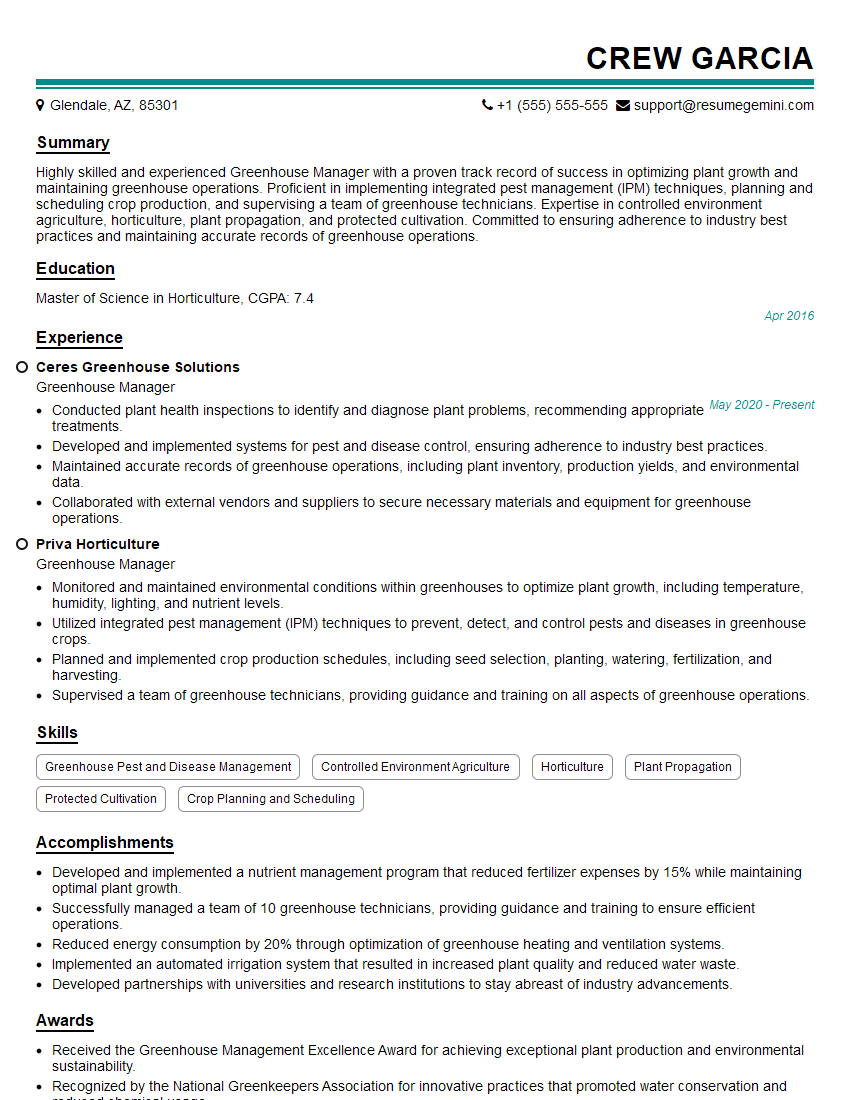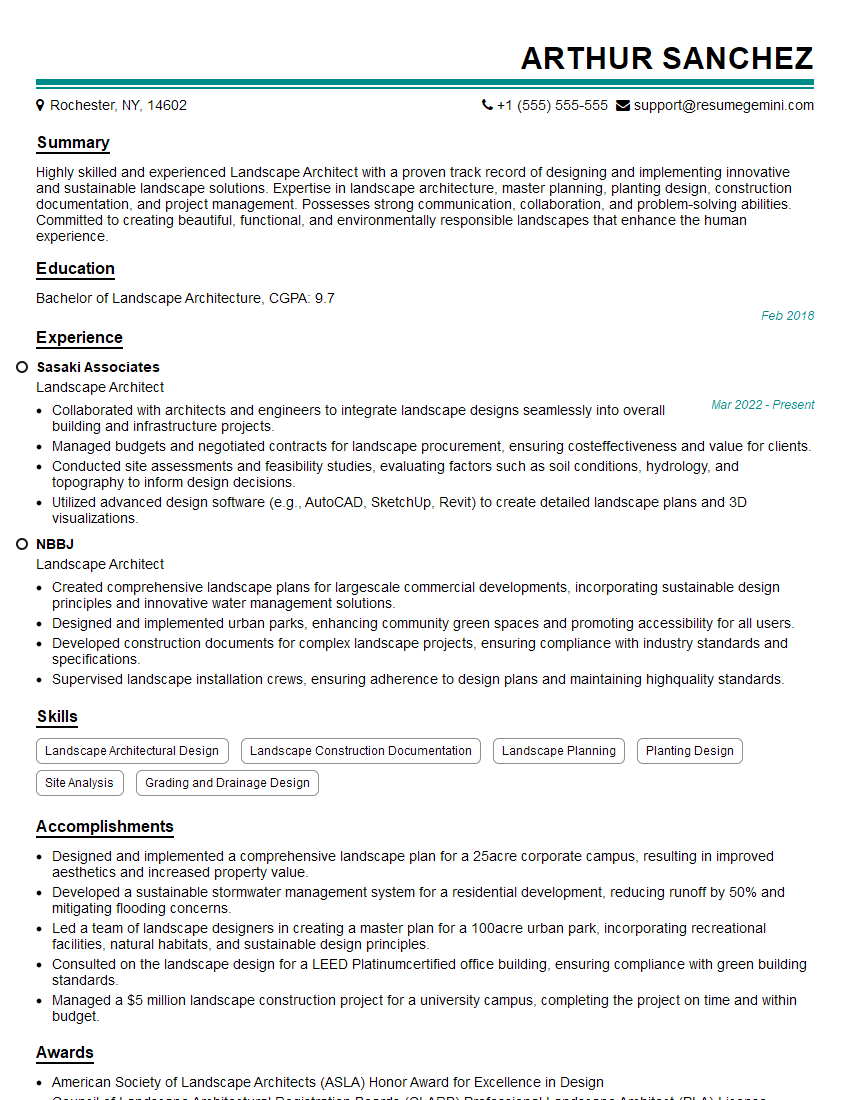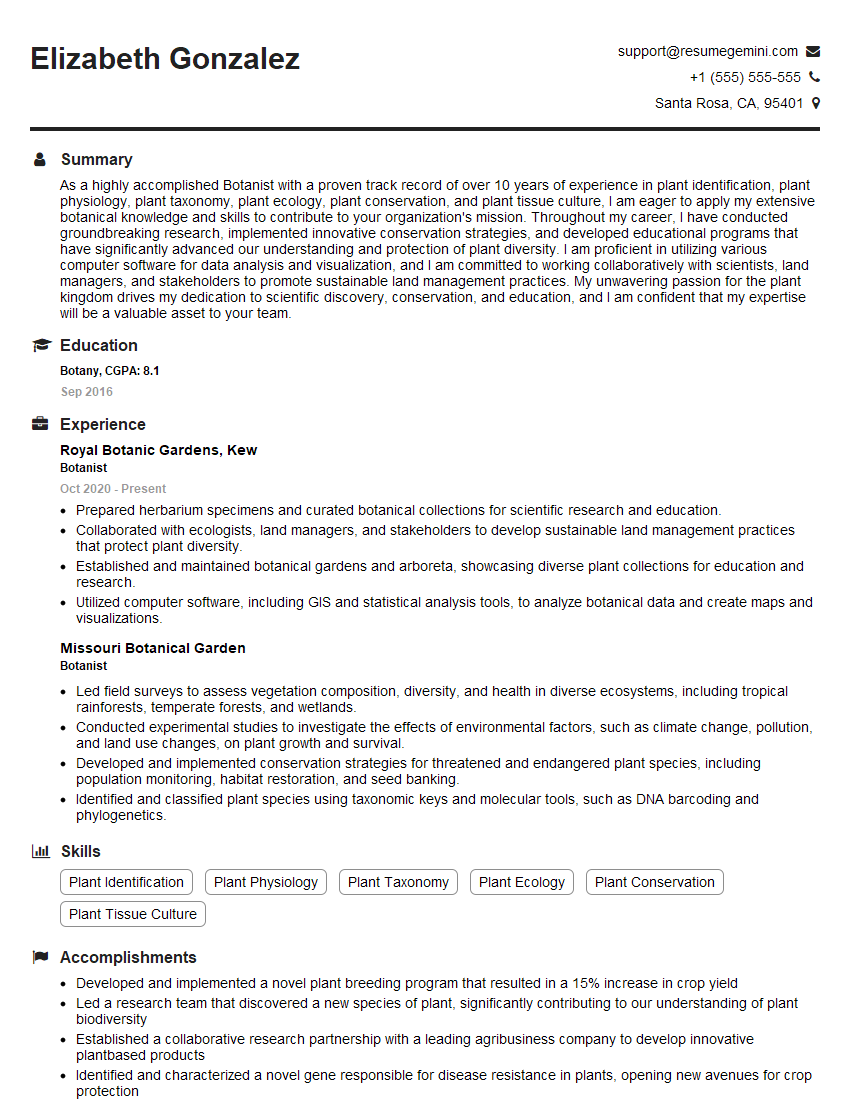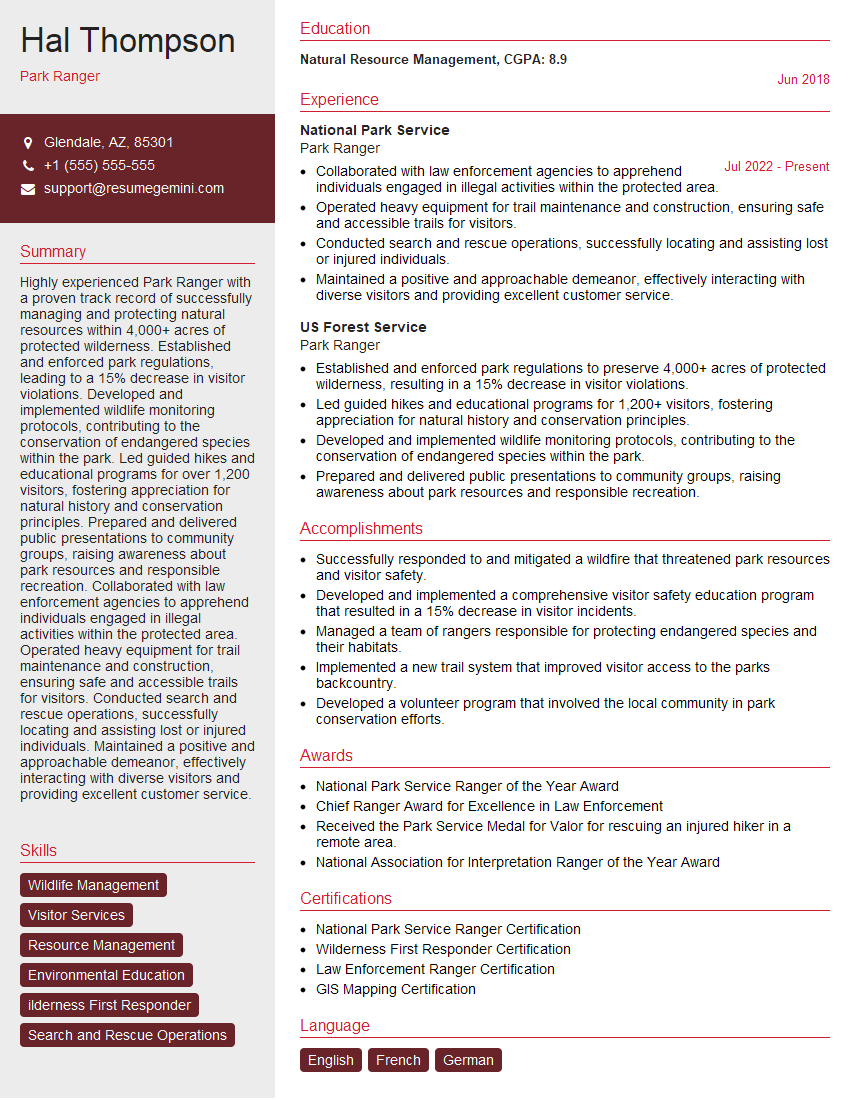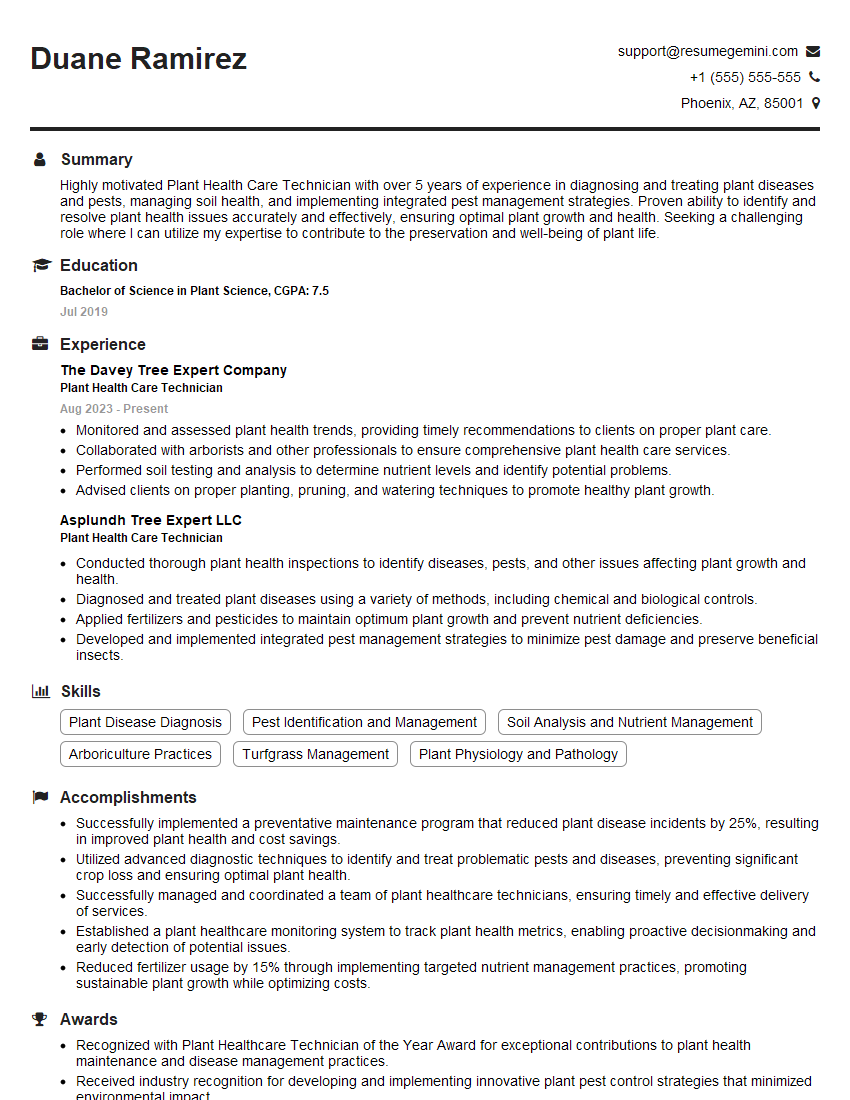Preparation is the key to success in any interview. In this post, we’ll explore crucial Tree and Shrub Identification interview questions and equip you with strategies to craft impactful answers. Whether you’re a beginner or a pro, these tips will elevate your preparation.
Questions Asked in Tree and Shrub Identification Interview
Q 1. What are the key distinguishing features of deciduous and evergreen trees?
The most significant difference between deciduous and evergreen trees lies in their leaf retention. Deciduous trees shed their leaves seasonally, typically in autumn or during dry periods, while evergreen trees retain their leaves year-round. Think of it like this: deciduous trees are like shedding snakes, getting rid of old skin (leaves) to make way for new growth; evergreens are like constantly wearing a thick coat, always protecting themselves from the elements. This difference is primarily driven by adaptation to climate. Deciduous trees are often found in regions with distinct seasons, where leaf shedding helps conserve water and energy during cold or dry periods. Evergreens, conversely, are prevalent in more consistently temperate or wet climates, where the benefit of year-round photosynthesis outweighs the cost of constant leaf maintenance. Examples of deciduous trees include oaks (Quercus spp.) and maples (Acer spp.), while evergreens include pines (Pinus spp.) and spruces (Picea spp.).
Q 2. Describe the process of identifying a tree using its leaves.
Leaf identification is a crucial step in tree identification. Begin by noting the overall leaf shape: is it needle-like, scale-like, or broadleaf? For broadleaves, consider the following features:
- Leaf Arrangement: Are leaves arranged alternately (one leaf per node), oppositely (two leaves per node), or whorled (more than two leaves per node)?
- Leaf Shape: Is it ovate (egg-shaped), lanceolate (lance-shaped), cordate (heart-shaped), etc.? Precise terminology is helpful here. Use a field guide with leaf shape diagrams as a visual aid.
- Leaf Margin: Is the edge of the leaf smooth (entire), toothed (serrate), lobed (deeply indented), or doubly serrate? Consider the size and spacing of teeth.
- Leaf Venation: How are the veins arranged? Is it pinnate (veins branching from a central midrib), palmate (veins radiating from a central point), or parallel?
- Leaf Texture: Is the leaf surface smooth, rough, hairy (pubescent), or leathery?
- Leaf Color and Fall Color: Note the color of the leaves during different seasons. This can be a key diagnostic feature.
By combining these characteristics, you can significantly narrow down the possibilities. For instance, a tree with oppositely arranged, simple, palmately lobed leaves with toothed margins is likely a maple.
Q 3. Explain the differences between simple and compound leaves.
The distinction between simple and compound leaves lies in how the leaf blade is divided. A simple leaf has a single, undivided leaf blade, even if it’s lobed or toothed. The leaf blade is attached to the stem by a petiole (leaf stalk). Examples include oak leaves and maple leaves. A compound leaf, on the other hand, has a leaf blade divided into several distinct leaflets, each leaflet being attached to a common petiole or rachis (leaf axis). These leaflets can be arranged pinnately (along a central axis, like a feather) or palmately (radiating from a central point, like fingers on a hand). Examples of pinnately compound leaves include ash leaves and walnut leaves, while palmately compound leaves are found on horse chestnut trees.
The key is to look for the presence or absence of a terminal bud at the end of the leaf structure. Simple leaves always have one, compound leaves do not (the terminal bud instead sits above the whole compound leaf).
Q 4. How do you identify trees using bark characteristics?
Bark characteristics provide valuable clues for tree identification, particularly in winter when leaves are absent. Examine the following aspects of the bark:
- Texture: Is the bark smooth, rough, scaly, flaky, furrowed, or shaggy?
- Color: What is the overall color of the bark? Does it vary with age?
- Pattern: Does the bark exhibit distinct patterns, such as vertical ridges, horizontal lenticels (pores), or interwoven plates?
- Thickness: How thick is the bark? Is it easily peeled or deeply fissured?
For example, young birch trees have smooth, papery bark, while mature birch bark becomes distinctive in its peeling, horizontal layers. Conversely, mature oak trees exhibit deeply furrowed, thick bark.
Q 5. What are the common characteristics used to identify shrubs?
Shrub identification relies on a combination of characteristics similar to tree identification, but with some key differences. Shrubs, unlike trees, typically have multiple stems arising from the ground, rather than a single trunk. Consider these characteristics:
- Overall Growth Habit: Is it upright, spreading, prostrate, or rounded?
- Bark: Similar to trees, examine bark texture and color, though bark will often be thinner and less developed.
- Leaves: Pay attention to leaf arrangement, shape, margin, venation, and texture, just as with trees.
- Flowers and Fruits: Flower shape, color, and arrangement and the presence of berries, nuts, or other fruits can be highly diagnostic.
- Height and Branching Pattern: Note the overall size and how the branches are distributed across the shrub.
For instance, distinguishing between different types of rhododendrons might involve looking at flower color, leaf shape, and overall size of the shrub.
Q 6. Name five common tree species found in your region and describe their key identifying features.
Note: The following examples are based on a temperate, North American region. Species will vary based on geographical location.
- American Elm (Ulmus americana): Distinctive vase-shaped crown, doubly-serrate leaves with asymmetrical bases, and coarse, furrowed bark.
- Sugar Maple (Acer saccharum): Oppositely arranged, 5-lobed leaves with pointed lobes, sharply serrated margins, and smooth, grey bark on younger trees.
- White Oak (Quercus alba): Rounded or spreading crown, deeply lobed leaves with rounded lobes, and light grey bark that becomes deeply furrowed with age.
- Red Pine (Pinus resinosa): Long needles (2 in a bundle), reddish-brown bark that becomes scaly and plate-like with age.
- Eastern White Pine (Pinus strobus): Long, soft needles (5 in a bundle), smooth, grey bark on young trees, that gradually becomes deeply furrowed and scaly.
Q 7. Explain the concept of plant taxonomy and its importance in tree and shrub identification.
Plant taxonomy is the science of classifying and naming plants. It’s a hierarchical system that organizes plants based on evolutionary relationships, shared characteristics, and genetic information. The system uses a binomial nomenclature, meaning each plant species is given a unique two-part name: the genus and the species (e.g., Quercus alba for White Oak).
Taxonomy is crucial in tree and shrub identification because it provides a structured framework for organizing and understanding the vast diversity of plant life. By understanding the taxonomic relationships between different species, we can predict their characteristics and better understand their evolutionary history. Field guides, databases, and identification keys all rely on the principles of plant taxonomy, making accurate identification easier and more reliable.
Q 8. How can you distinguish between different species of oak trees?
Identifying oak species can seem daunting at first, but focusing on key features simplifies the process. The most crucial distinctions lie in leaf shape, acorn characteristics, and overall tree form.
- Leaf Shape: Look at the leaf lobes. Are they rounded (like in a White Oak, Quercus alba), pointed (like in a Red Oak, Quercus rubra), or somewhere in between? The number of lobes and their depth also vary significantly between species. For example, a pin oak (Quercus palustris) has deeply lobed leaves with slender, pointed lobes that give a very distinctive silhouette.
- Acorn Characteristics: Examine the acorn cap (cupule). How much of the acorn does it cover? Is the cap scaly or smooth? The size and shape of the acorn itself are also important identifiers. White oaks generally have acorns that mature in one season and have a sweeter taste, whereas red oaks have acorns that take two years to mature and are more bitter.
- Tree Form: Consider the overall shape and branching pattern of the tree. Some oaks have a rounded crown, while others are more pyramidal or even weeping. This is less reliable than leaf and acorn characteristics but can be helpful in conjunction with other observations.
For example, if you encounter an oak with rounded lobes, a cupule that covers a small portion of the acorn, and a generally rounded crown, you’re likely looking at a White Oak. Conversely, pointed lobes, a cupule that covers a significant portion of the acorn, and a more upright form point towards a Red Oak.
Q 9. How do you use dichotomous keys for plant identification?
Dichotomous keys are invaluable tools for plant identification. They are structured as a series of paired statements (couplets) that present two contrasting choices. By carefully examining the plant and selecting the statement that best matches its characteristics, you progress through the key until you arrive at an identification.
Think of it like a sophisticated flow chart. Each step narrows down the possibilities. For instance, a key might start with:
- 1a. Leaves opposite…go to 2
- 1b. Leaves alternate…go to 3
If your plant has opposite leaves, you proceed to step 2; otherwise, you go to step 3. Each subsequent step offers further choices until you reach a species name.
Successful key usage requires meticulous observation and accurate recording of plant features like leaf arrangement, flower structure, fruit type, bark texture, and overall plant habit. It’s crucial to use a key designed for the specific region and plant group you’re working with, as keys are tailored to specific floras. Misinterpreting a feature can lead to incorrect identification.
Q 10. Describe the process of identifying a diseased or damaged tree or shrub.
Identifying a diseased or damaged tree or shrub is a multi-step process that requires keen observation and sometimes specialized knowledge.
- Visual Inspection: Begin by carefully examining the entire plant – from its roots (if accessible) to its crown. Look for symptoms like leaf discoloration (chlorosis, browning, spots), wilting, dieback of branches, cankers (sunken areas on the bark), unusual growths (galls), insect infestations, and root damage. Take photos to document your findings.
- Sampling and Testing (if needed): For more accurate diagnosis, samples of leaves, branches, or roots might need to be collected and sent to a diagnostic laboratory for analysis. This is especially important when dealing with unknown diseases or suspected pathogens.
- Environmental Factors: Consider environmental factors such as drought stress, nutrient deficiencies, soil compaction, and pollution that can mimic disease symptoms.
- Pest Identification: If insects or mites are suspected, collect samples and identify the species for appropriate control measures.
- Disease Diagnosis: Based on the visual symptoms, environmental factors, and lab results (if any), determine the likely cause of the damage. Consulting with a certified arborist or plant pathologist can be invaluable for difficult cases.
For example, if you notice a tree with wilting leaves, yellowing foliage, and possibly some dieback, you would need to check the root system for any signs of rot or damage. The combination of symptoms could indicate root rot or a vascular disease, requiring further investigation.
Q 11. What are some common pests and diseases affecting trees and shrubs in your area?
(Note: The specific pests and diseases will vary greatly depending on your geographic location. This answer provides examples – replace these with the common pests and diseases prevalent in *your* specific area.)
Common pests and diseases affecting trees and shrubs in [insert your area] include:
- Insects: Aphids, spider mites, scale insects, borers (like the Emerald Ash Borer), and various caterpillars. These insects cause direct damage through feeding on leaves, stems, or roots.
- Diseases: Anthracnose (leaf spot disease), powdery mildew (fungal infection), root rot (caused by various fungi), and leaf blight. These diseases can affect different parts of the plant, leading to leaf loss, dieback, and even plant death.
For instance, the Emerald Ash Borer is an invasive pest devastating ash trees in many parts of North America. Early detection and intervention are crucial for managing these pests and diseases. Regular monitoring and proactive measures, such as proper sanitation and appropriate pesticide use (when necessary), are vital for maintaining healthy trees and shrubs.
Q 12. How do you identify different types of soil and their effect on tree and shrub growth?
Soil type significantly impacts tree and shrub growth. Accurate identification relies on visual assessment, feel, and sometimes laboratory testing.
- Visual Assessment: Observe the soil color, texture (sandy, silty, or clay-like), and presence of rocks or organic matter. A dark color often indicates high organic content.
- Feel Test: Rub some damp soil between your fingers. Sandy soil feels gritty, silty soil is smooth, and clay soil is sticky and forms a ribbon when rolled.
- Drainage Test: Dig a hole and fill it with water. Observe how quickly the water drains. Rapid drainage suggests sandy soil, slow drainage indicates clay soil.
- pH Testing: A soil pH test measures soil acidity or alkalinity. Most plants thrive within a specific pH range. Kits are readily available for home testing, or a soil sample can be sent to a laboratory.
Sandy soils drain quickly but are low in nutrients and water retention. Clay soils retain water and nutrients but can be poorly drained, leading to root rot. Loamy soils (a mix of sand, silt, and clay) offer a good balance of drainage and nutrient retention, ideal for most trees and shrubs. Understanding soil type guides planting decisions and helps address nutrient deficiencies or drainage problems.
Q 13. Explain the importance of proper pruning techniques for different tree and shrub species.
Proper pruning techniques are essential for maintaining the health, form, and longevity of trees and shrubs. The methods vary considerably depending on the species and the desired outcome.
- Timing: Many woody plants are best pruned during their dormant season (late winter/early spring) to minimize sap loss and disease risk. However, some, like rhododendrons, are best pruned right after flowering.
- Types of Pruning:
- Thinning: Removing entire branches back to their origin point. This improves light penetration, air circulation, and overall tree structure.
- Heading: Cutting back branches to a lateral bud or shoot. It promotes bushier growth but can create weak branch unions.
- Renewal Pruning: Cutting back mature shrubs to encourage vigorous new growth from the base.
- Species-Specific Considerations: Some trees and shrubs respond differently to pruning. For example, over-pruning some evergreens can damage their shape. Other species, like certain fruit trees, require specific techniques for fruit production.
For example, improperly pruning a birch tree can lead to unsightly wounds and disease entry. Always use sharp, clean tools and make cuts just above a branch collar to minimize damage. If you are unsure about how to prune a specific species, consulting a professional arborist is recommended.
Q 14. Describe the various methods of tree propagation.
Tree propagation involves various techniques to create new plants from existing ones. These methods generally fall under two categories: sexual propagation (using seeds) and asexual propagation (using vegetative parts of the plant).
- Sexual Propagation (from seed): This is the natural method but can be unpredictable as offspring may not be identical to the parent plant. Seed collection, stratification (cold treatment to break dormancy), and germination are important steps. Some seeds require specific conditions for successful germination.
- Asexual Propagation (vegetative): This method creates genetically identical clones of the parent plant. Techniques include:
- Cuttings: Taking stem, leaf, or root cuttings and rooting them to create new plants.
- Grafting: Joining a scion (desired variety) onto a rootstock (base plant). This is commonly used for fruit trees to combine desirable fruit traits with rootstock characteristics like disease resistance.
- Layering: Bending a branch to the ground, covering it with soil, and encouraging root formation before separating it from the parent plant.
- Air Layering: Similar to layering, but the branch is not buried, rather it is wrapped with damp moss to encourage root formation before being separated.
- Division: Separating a clump-forming plant into smaller divisions that can be replanted.
The choice of propagation method depends on the species, desired quantity of plants, and the resources available. Grafting, for example, is often preferred for fruit trees to ensure fruit quality and consistency, while cuttings are a simpler method for propagating many shrubs.
Q 15. What are the different types of root systems found in trees and shrubs?
Trees and shrubs exhibit two primary root system types: taproots and fibrous roots. Understanding these differences is crucial for successful planting and long-term health.
- Taproot systems: Characterized by a single, dominant central root that grows vertically downwards, with smaller lateral roots branching off. This system is common in many trees like oaks and carrots, providing deep anchorage and access to groundwater. Think of it like a sturdy anchor for a large ship.
- Fibrous root systems: Composed of a dense network of similarly sized roots spreading horizontally near the soil surface. This is typical of many shrubs and grasses, maximizing water and nutrient absorption from a wider area. Imagine a vast, interconnected web efficiently collecting resources.
Some species, like certain pines, may even exhibit a combination of both systems, initially developing a taproot and then transitioning to a more extensive fibrous network as they mature.
Career Expert Tips:
- Ace those interviews! Prepare effectively by reviewing the Top 50 Most Common Interview Questions on ResumeGemini.
- Navigate your job search with confidence! Explore a wide range of Career Tips on ResumeGemini. Learn about common challenges and recommendations to overcome them.
- Craft the perfect resume! Master the Art of Resume Writing with ResumeGemini’s guide. Showcase your unique qualifications and achievements effectively.
- Don’t miss out on holiday savings! Build your dream resume with ResumeGemini’s ATS optimized templates.
Q 16. What are the signs of drought stress in trees and shrubs?
Recognizing drought stress in trees and shrubs is vital for timely intervention. Symptoms often manifest gradually but become increasingly apparent as water scarcity worsens.
- Wilting leaves: Leaves droop and become less turgid, initially recovering at night but eventually remaining wilted even after watering.
- Leaf scorch: Brown, crispy edges or patches develop on leaves, starting at the margins and progressing inwards. This is often irreversible.
- Reduced growth: New growth is stunted or absent, and overall growth rate slows significantly.
- Premature leaf drop: Trees and shrubs may shed leaves prematurely to conserve water, especially during severe drought.
- Changes in bark: In some cases, the bark may appear cracked or unusually dry.
Early detection is key. Consider the species’ natural drought tolerance – some are naturally more resistant than others – when assessing severity.
Q 17. How do you assess the health of a tree?
Assessing tree health involves a holistic approach, considering various factors that can impact vitality. A systematic evaluation is essential.
- Visual inspection: Observe the overall structure, looking for signs of disease, pests, or physical damage. Assess crown density, leaf color, and branch vigor.
- Trunk and bark examination: Check for cracks, cavities, cankers, or unusual growths. Look for signs of fungal infections or insect infestations.
- Root system evaluation: While less direct, observe the surrounding soil for signs of root damage or compaction. This might require digging cautiously around the base of the tree.
- Growth measurements: Monitor growth rate over several years to identify unusual trends indicating potential problems.
- Soil testing: Analyze soil conditions to determine nutrient levels, pH, and drainage. Poor soil can significantly impact health.
If you find any concerning symptoms, consider consulting an arborist for a professional assessment. They possess the tools and expertise to conduct a more in-depth diagnosis.
Q 18. Describe the process of site preparation for planting trees and shrubs.
Proper site preparation is fundamental to successful tree and shrub planting, ensuring establishment and long-term health. It involves several key steps.
- Site selection: Choose a location that meets the species’ light, soil, and moisture requirements. Consider mature size and root spread.
- Soil testing: Determine soil pH, nutrient levels, and drainage characteristics. Amend the soil as needed to optimize conditions.
- Clearing and excavation: Remove existing vegetation, rocks, and debris from the planting area. Dig a hole at least twice as wide and as deep as the root ball.
- Soil amendment: Mix topsoil with organic matter, such as compost, to improve soil structure and nutrient content.
- Proper planting: Carefully place the plant in the hole, ensuring the root flare (the point where the trunk meets the roots) is at or slightly above ground level. Fill the hole with amended soil, firming gently.
- Watering: Water deeply after planting to eliminate air pockets and ensure good soil-root contact.
Careful planning and thorough site preparation pay off significantly by reducing stress on newly planted trees and shrubs, giving them the best possible start.
Q 19. What are the factors to consider when selecting trees and shrubs for a specific landscape?
Selecting the right trees and shrubs for a landscape is a crucial decision impacting both aesthetic appeal and long-term success. Several factors must be considered.
- Climate: Choose species that are adapted to your local climate, including temperature extremes, rainfall patterns, and sunlight exposure.
- Soil conditions: Select plants suited to your soil type – sandy, clay, loamy, etc. – and pH levels.
- Mature size: Account for the mature size of trees and shrubs to avoid overcrowding or conflicts with existing structures.
- Light requirements: Consider the amount of sunlight available in the planting area. Some plants require full sun, while others thrive in shade.
- Maintenance requirements: Choose species with appropriate maintenance needs – pruning, fertilization, disease resistance – that align with your capabilities and preferences.
- Aesthetic considerations: Select plants that complement the overall landscape design and your personal preferences in terms of color, texture, and form.
Thorough research and consultation with local nurseries or landscape professionals can guide you towards the best choices for your specific landscape.
Q 20. How do you determine the appropriate spacing for planting trees and shrubs?
Appropriate spacing for planting trees and shrubs is essential to prevent overcrowding, ensure proper growth, and maintain a balanced landscape. The specific spacing depends on several factors.
- Mature size: The ultimate size of the tree or shrub is the primary determinant. Allow ample space for the plants to reach their full size without competing for resources.
- Species: Different species have different growth habits and spreading patterns. Some grow wider, while others grow taller. Consult species-specific guidelines.
- Landscape design: The overall design of the landscape dictates spacing considerations. Consider the placement of other plants, hardscapes, and structures.
For example, a large shade tree may require 30-40 feet of spacing, while a small flowering shrub might only need 2-3 feet. Refer to planting guides or consult landscape professionals for specific recommendations based on your chosen species and design.
Q 21. Explain the different methods of irrigation for trees and shrubs.
Efficient irrigation is critical for the health of trees and shrubs, especially during establishment and periods of drought. Various methods are available, each with advantages and disadvantages.
- Drip irrigation: Delivers water directly to the roots, minimizing water loss through evaporation. Ideal for individual plants or small areas.
- Soaker hoses: Similar to drip irrigation, but provide a more continuous, gentle flow of water over a larger area.
- Sprinkler systems: Effective for larger areas, but can lead to higher water loss through evaporation and runoff.
- Hand watering: Offers precise control but is labor-intensive and may not be suitable for large landscapes.
The most suitable method depends on factors like landscape size, plant density, and water availability. A combination of methods may be employed for optimal results. Consider water conservation and efficiency when choosing an irrigation system.
Q 22. How do you manage invasive plant species?
Managing invasive plant species requires a multi-pronged approach combining prevention, early detection, and control. Prevention focuses on avoiding the introduction of invasive species through careful selection of planting materials and rigorous inspection of equipment and vehicles. Early detection involves regular monitoring of areas at risk, often using surveys and remote sensing techniques to identify small infestations before they become widespread. Control methods vary depending on the species and the severity of the infestation. These can include manual removal (digging up plants), herbicide application (chemical control), biological control (introducing natural predators or pathogens), or a combination of these approaches. For example, Japanese knotweed, a notoriously difficult invasive, often requires a combination of repeated herbicide treatments and careful monitoring over many years. Choosing the right control method requires a detailed understanding of the target species’ biology and the local environment to minimize unintended consequences.
Successful invasive species management also involves public education and community engagement. Educating the public about the impacts of invasive plants and promoting responsible gardening practices can significantly reduce the spread of these problematic species. For instance, encouraging the use of native plant species instead of non-native ornamentals helps maintain biodiversity and reduces the risk of invasion.
Q 23. Describe different tree planting techniques.
Tree planting techniques depend on several factors, including the species of tree, the size of the tree (seedling, sapling, or larger), the soil conditions, and the desired outcome. Several key steps are common to most techniques:
- Site preparation: This involves assessing the site for appropriate sunlight, drainage, and soil conditions. Removing competing vegetation and amending the soil with organic matter as needed is crucial. For instance, poorly draining soil may require the addition of gravel or sand to improve drainage.
- Planting hole preparation: The hole should be wide enough to accommodate the root ball without restricting root growth and deep enough to allow for proper planting depth. Avoid planting too deep or too shallow; the root flare (where the roots meet the trunk) should be level with or slightly above the ground.
- Planting: Gently remove the tree from its container, loosening any circling roots. Place the tree in the hole, ensuring the root flare is at the correct level, and backfill with soil, gently tamping to eliminate air pockets. Watering thoroughly after planting is vital to ensure good root-soil contact.
- Staking and guying (optional): For larger trees or those planted in exposed locations, staking can help prevent wind damage. Guying uses ropes and stakes to provide support. However, excessive staking can hinder root development, so it should only be used when absolutely necessary.
- Watering and mulching: Regular watering, especially during dry periods, is essential, especially during the first year or two after planting. Mulching helps retain moisture, suppress weeds, and regulate soil temperature.
Different techniques exist for planting bare-root seedlings (directly planting roots) versus container-grown saplings (planted with soil around the roots). Each requires slight adjustments to the steps above. For instance, bare-root seedlings need careful handling to prevent root damage.
Q 24. How do you recognize and address common tree and shrub problems?
Recognizing and addressing tree and shrub problems requires careful observation and a systematic approach. Common problems include diseases, pests, nutrient deficiencies, and environmental stresses such as drought or frost damage.
Initial assessment involves carefully examining the plant for symptoms: Changes in leaf color (chlorosis – yellowing, or necrosis – browning), unusual growths (galls), wilting, dieback, or presence of insects or other organisms. A hand lens can be invaluable for close examination of insects and leaf damage.
Once the problem is identified, appropriate action can be taken. This may involve pruning affected branches, applying appropriate fungicides or insecticides (following label instructions carefully), addressing nutrient deficiencies through fertilization, or improving growing conditions such as watering or drainage. For example, if a tree shows signs of root rot, improving drainage and possibly replacing the soil is important. If the symptoms point to an insect infestation, you might use beneficial nematodes, insecticidal soap, or targeted insecticides. In some cases, consultation with an arborist or plant pathologist is necessary for accurate diagnosis and treatment, especially for serious or unknown problems.
Q 25. What safety precautions should be taken when working with trees and shrubs?
Safety precautions when working with trees and shrubs are paramount. These precautions should be adapted to the specific tasks and the size and species of the plant.
- Personal Protective Equipment (PPE): Always wear appropriate PPE, including gloves, eye protection, and sturdy footwear. When using chemicals, protective clothing, respirators, and chemical-resistant gloves are crucial. Long sleeves and pants protect against thorns and irritants.
- Tool safety: Ensure all tools are sharp and well-maintained. Use tools correctly, following manufacturer instructions, and be mindful of others around you.
- Tree climbing safety: If climbing trees, use appropriate climbing gear and follow established safety protocols. Never climb a tree that is unstable or diseased. Always have a spotter.
- Chemical safety: Follow all label instructions when using pesticides or herbicides. Store chemicals properly and avoid spills or accidental ingestion.
- Environmental awareness: Be aware of potential hazards in the work area, such as overhead power lines, underground utilities, and unstable terrain.
It’s vital to assess risks before any work begins and to adjust safety protocols accordingly. For instance, working with a large, potentially unstable tree requires a different approach and higher level of safety equipment compared to pruning a small shrub. Regular safety training is essential for anyone working with trees and shrubs.
Q 26. Explain the importance of tree and shrub identification in urban forestry.
Accurate tree and shrub identification is fundamental to urban forestry for several reasons:
- Species selection: Choosing the right tree species for a particular location is crucial for success. This involves considering factors such as soil type, climate, available space, and desired aesthetic outcome. Incorrect species selection can lead to plant failure and wasted resources.
- Pest and disease management: Identifying trees and shrubs accurately allows for targeted pest and disease control. Knowing the species allows you to identify potential problems early and apply appropriate treatments. This approach is much more efficient and effective than a blanket approach that might not be suitable for every species.
- Maintenance and pruning: Proper pruning techniques vary by species. Accurate identification ensures that pruning is done correctly, promoting healthy growth and preventing damage.
- Inventory and planning: Accurate identification is essential for maintaining an inventory of urban trees and shrubs. This information is vital for urban planning, informing decisions about tree planting, removal, and maintenance strategies.
- Environmental impact assessment: Knowing the species present allows for a better understanding of the ecological impacts of urban forestry practices, helping to promote biodiversity and minimize negative environmental impacts.
In essence, accurate identification forms the bedrock of effective and sustainable urban forestry practices.
Q 27. How do you use tools such as a hand lens or a dendrometer?
A hand lens, or magnifying glass, is used to examine small details of plant structures, such as leaf venation, flower parts, and insect damage. It provides a magnified view, allowing for more precise identification. For example, identifying a specific species of oak often requires careful examination of leaf shape and the arrangement of leaf veins, details best observed using a hand lens.
A dendrometer is a tool used to measure tree diameter. It typically consists of a flexible steel tape wrapped around the tree trunk at breast height (DBH – 4.5 feet above ground level). The circumference measurement is then used to calculate the tree’s diameter. Dendrometers are essential for monitoring tree growth, assessing tree health, and making informed decisions regarding tree management. The data collected is used to track tree growth over time, aiding in determining the effectiveness of management practices and predicting future tree size.
Q 28. Describe your experience using field guides and online resources for plant identification.
Field guides and online resources are indispensable tools for plant identification. I’ve extensively utilized numerous field guides, ranging from regional floras focusing on specific geographic areas to broader guides covering larger taxonomic groups. The choice of field guide depends on the context—a regional flora is preferred when working within a particular geographic area, while a broader guide might be more suitable for identifying plants during travel. For instance, I often use Peterson’s field guides for their detailed illustrations and descriptions.
Online resources have become increasingly valuable in recent years. Websites and apps provide detailed information on plant species, often including photographs, distribution maps, and identification keys. These resources can be particularly useful for confirming identifications made using field guides or for accessing information on less-common species. However, it is crucial to critically evaluate the source’s credibility and accuracy before relying on its information. I often cross-reference information from multiple online resources and compare it with data from trusted field guides. I regularly consult reputable websites such as university herbariums, botanical gardens, and government agencies dedicated to plant conservation.
Key Topics to Learn for Tree and Shrub Identification Interview
- Leaf Morphology and Arrangement: Understanding leaf shapes, margins, venation patterns, and arrangements (alternate, opposite, whorled) is fundamental for accurate identification. Practical application: Quickly differentiate between similar species in the field.
- Bark Characteristics: Learning to identify bark texture, color, and patterns (lenticels, fissures) provides crucial clues, especially in winter. Practical application: Identifying trees even when leaves are absent.
- Buds and Twigs: Examining bud shape, size, and arrangement, along with twig characteristics like color and lenticels, aids in identification. Practical application: Identifying dormant trees and shrubs.
- Flower and Fruit Structures: Understanding floral morphology (flower parts, symmetry) and fruit types (berries, drupes, etc.) provides key distinguishing features. Practical application: Identifying trees and shrubs during their flowering and fruiting seasons.
- Growth Habits and Habitats: Recognizing typical growth forms (tree, shrub, vine) and understanding the environmental preferences of different species (sun, shade, soil type) is critical. Practical application: Predicting species distribution and suitable planting locations.
- Dichotomous Keys and Identification Resources: Mastering the use of dichotomous keys and becoming familiar with reliable field guides and online resources is essential for successful identification. Practical application: Efficiently and accurately identifying unknown plants.
- Pest and Disease Identification: Familiarity with common pests and diseases affecting trees and shrubs allows for effective problem-solving and management strategies. Practical application: Preventing and mitigating damage to plant health.
Next Steps
Mastering tree and shrub identification is crucial for career advancement in various fields, including horticulture, arboriculture, landscaping, and forestry. A strong understanding of these skills showcases expertise and dedication to the profession. To maximize your job prospects, create an ATS-friendly resume that highlights your relevant skills and experience. ResumeGemini is a trusted resource that can help you build a professional and effective resume. They provide examples of resumes tailored to the Tree and Shrub Identification field to give you a head start.
Explore more articles
Users Rating of Our Blogs
Share Your Experience
We value your feedback! Please rate our content and share your thoughts (optional).
What Readers Say About Our Blog
Hello,
We found issues with your domain’s email setup that may be sending your messages to spam or blocking them completely. InboxShield Mini shows you how to fix it in minutes — no tech skills required.
Scan your domain now for details: https://inboxshield-mini.com/
— Adam @ InboxShield Mini
Reply STOP to unsubscribe
Hi, are you owner of interviewgemini.com? What if I told you I could help you find extra time in your schedule, reconnect with leads you didn’t even realize you missed, and bring in more “I want to work with you” conversations, without increasing your ad spend or hiring a full-time employee?
All with a flexible, budget-friendly service that could easily pay for itself. Sounds good?
Would it be nice to jump on a quick 10-minute call so I can show you exactly how we make this work?
Best,
Hapei
Marketing Director
Hey, I know you’re the owner of interviewgemini.com. I’ll be quick.
Fundraising for your business is tough and time-consuming. We make it easier by guaranteeing two private investor meetings each month, for six months. No demos, no pitch events – just direct introductions to active investors matched to your startup.
If youR17;re raising, this could help you build real momentum. Want me to send more info?
Hi, I represent an SEO company that specialises in getting you AI citations and higher rankings on Google. I’d like to offer you a 100% free SEO audit for your website. Would you be interested?
Hi, I represent an SEO company that specialises in getting you AI citations and higher rankings on Google. I’d like to offer you a 100% free SEO audit for your website. Would you be interested?
good
